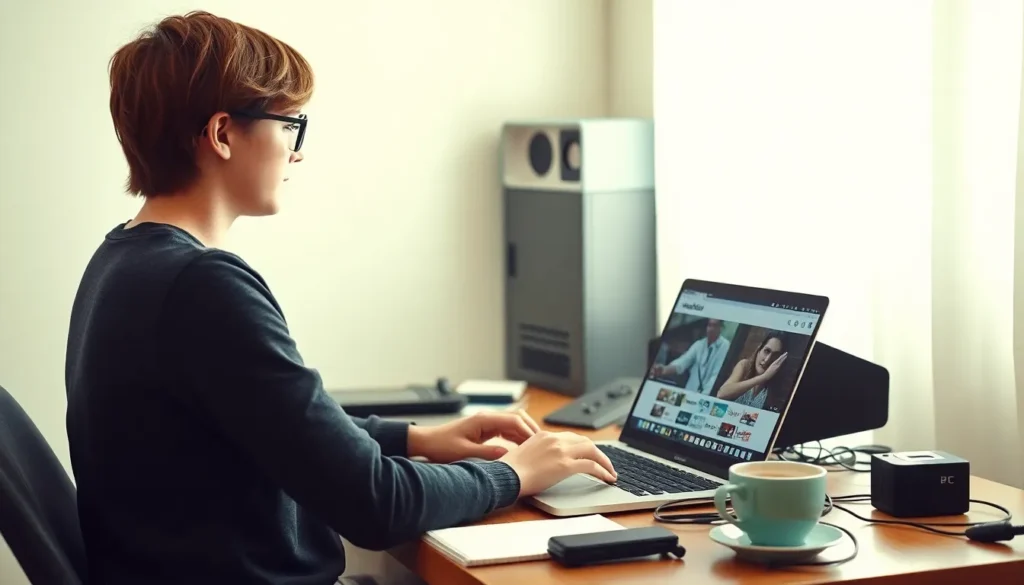Table of Contents
ToggleChanging the side button on an iPhone might sound like a task reserved for tech wizards or Apple’s secret agents, but it’s easier than you think. Whether you’re looking to switch up your device’s functionality or just want to impress your friends with your newfound skills, this guide will make you the hero of your own tech story.
Understanding the Side Button Functionality
The side button on an iPhone serves multiple purposes essential to user experience. Recognizing its default functions helps users utilize the device efficiently.
Default Functions of the Side Button
The side button initiates various tasks. It locks the screen effortlessly, secures device access, and activates Siri. Users can also press it to take screenshots quickly. When pressed in combination with the volume buttons, it can trigger emergency SOS features. Operating these functions efficiently simplifies daily interactions with the iPhone.
Customization Options Available
Customization enhances the side button’s usability. Users can adjust settings to suit personal preferences. For instance, they can enable specific actions like accessibility shortcuts or activating the camera with double presses. Adjusting these options allows for a more tailored experience. Access these settings through the iPhone’s Control Center or the Accessibility menu for quick adjustments.
Steps to Change the Side Button Settings
Changing the side button settings on an iPhone involves a few simple steps. Users can customize this button to enhance their experience.
Navigating to Settings
Open the Settings app on the iPhone. Locate the “Accessibility” option within the menu. Tapping on “Accessibility” reveals various features to improve device usability. Scroll down to find the “Physical and Motor” section. Here, users can select “Side Button” to access relevant settings.
Customizing the Side Button Functions
Customize the functions of the side button by selecting options under “Press and Hold” and “Double Press.” Choose from features like activating Siri, enabling accessibility shortcuts, or launching the camera. Each option allows users to personalize their experience. Save your changes, and the side button will respond according to the selected preferences. Enjoy the new functionalities that make device interaction smoother.
Troubleshooting Common Issues
Changes to the side button settings may not always take effect as expected. First, check that the user has saved changes properly in the Settings app. Restarting the iPhone sometimes resolves minor glitches. It’s also beneficial to ensure the iOS is updated, as software updates often fix bugs. If problems persist, resetting all settings can restore default configurations without data loss.
What to Do if Changes Don’t Take Effect
Changes might not register due to software glitches. Start by ensuring the device runs the latest version of iOS. Checking for updates in Settings can reveal important new releases. Users may also try toggling the side button settings off and on again. If settings still don’t apply, restarting the device often clears temporary issues. Be sure to confirm that changes were saved after adjustments.
Fixes for Non-Responsive Side Buttons
Non-responsive side buttons can hinder device functionality. First, clean the area around the side button with a soft, dry cloth to remove any debris. If the button remains unresponsive, checking for physical damage is crucial. A hardware issue could require professional repair. It helps to perform a force restart by pressing the volume up, then the volume down buttons, followed by pressing and holding the side button. If the device still doesn’t respond, consulting Apple’s support may provide additional options.
Alternatives to Customization
Customizing the side button isn’t the only way to enhance its functionality. Several alternatives provide additional options users can consider.
Using Accessibility Features
Accessibility features offer practical solutions for adjusting the side button’s functions. Users can enable features like Voice Control, which lets them operate the iPhone hands-free. Voice Control interacts with the side button, allowing for commands without physical interaction. Additionally, users can customize Switch Control settings. This feature enables users to assign specific functions related to the side button, providing a tailored experience for individuals with mobility challenges. Adaptive shortcuts make it easier for everyone, enriching their interactions with the device.
Exploring Third-Party Apps
Third-party apps extend the functionality of the iPhone’s side button. Developers create applications specifically designed to map side button functions to various tasks. Users can explore options that allow them to use the side button for launching specific apps, activating features, or controlling music. Popular apps often offer additional customization settings that create a more personalized user experience. By searching the App Store for productivity or accessibility tools, users can discover innovative ways to utilize the side button, making everyday tasks quicker and more efficient.
Changing the side button on an iPhone opens up a world of customization and efficiency. By following the outlined steps users can easily adjust the button’s functionality to better suit their needs. This not only enhances the overall user experience but also showcases individual tech-savviness.
With options to activate Siri or launch the camera with a simple double press users can streamline their interactions. Troubleshooting tips ensure that any issues are quickly resolved, allowing for a seamless transition to personalized settings. Exploring additional accessibility features and third-party apps can further maximize the side button’s potential, making everyday tasks simpler and more enjoyable. Embracing these changes empowers users to take full control of their devices.




